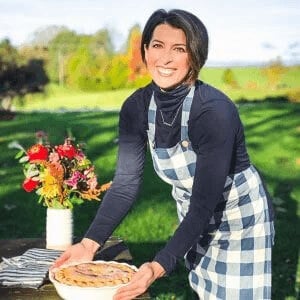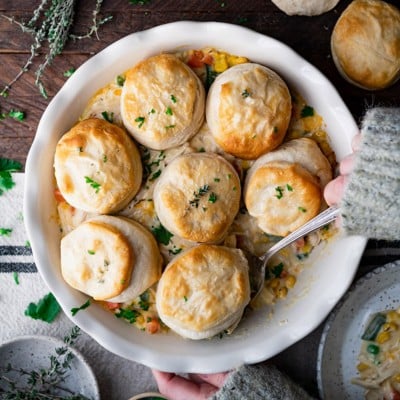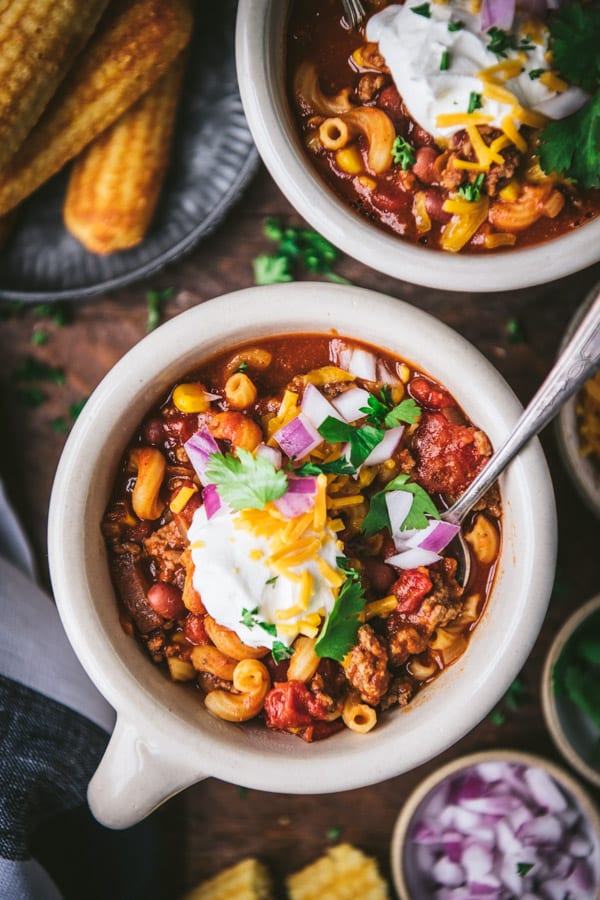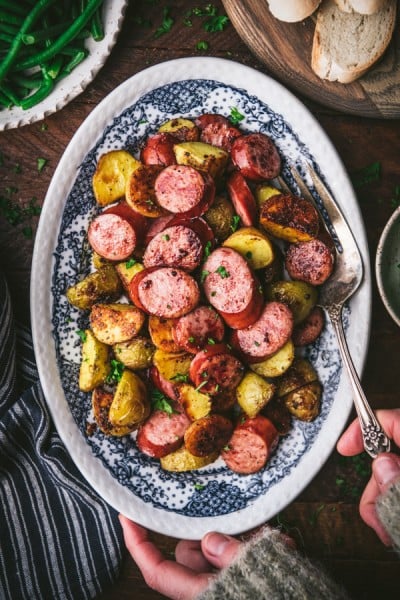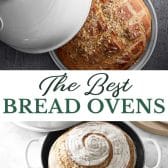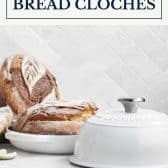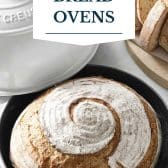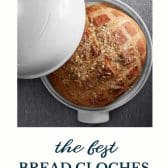Disclosure: This post may contain affiliate links. I may earn a small commission for my endorsement, recommendation, testimonial, and/or link to any products or services from this website.
There’s nothing quite like a fresh loaf of bread straight out of the oven. Whether you’re an expert baker or new to breadmaking, the best bread cloches will ensure that your loaves come out with a perfectly browned crust and a moist, chewy interior.

Table of Contents
To create our list of the best bread cloches (also called bread ovens), Blair and I researched the top models from the most well-known brands, like Emile Henry and King Arthur. We narrowed choices down based on design, material, and care. Blair loves Le Creuset products and thinks their cast iron bread oven looks like a great option, but we also included popular picks from other trusted brands!
Below, check out the best bread cloches to shop.
Our Top Picks:
- Blair’s Top Pick: Le Creuset Enameled Cast Iron Bread Oven – $289.95 at Amazon
- Best Budget Bread Cloche: King Arthur Cloche Bread Baker – $64.95 at King Arthur
- Best Classic Cast Iron: Challenger Breadware Challenger Bread Pan – $299 at Amazon
- Best Clay Bread Cloche: Sassafras Superstone La Cloche Bread Baker – $80 at Amazon
- Best Ceramic: Emile Henry Bread Cloche – $159.95 at Amazon
Reviews of The Best Bread Cloches
1. Blair’s Top Pick: Le Creuset Enameled Cast Iron Bread Oven

While Le Creuset cookware is definitely an investment, Blair loves the brand and believes they’re heirloom pieces that will last you a lifetime. This bread oven has Le Creuset’s signature enameled cast iron finish, which helps evenly distribute heat while trapping just enough moisture — this helps to create a golden crust and a perfectly baked loaf of bread.
The 1.75-quart size is also ideal for bread-making. Smaller bread ovens yield higher, rounder loaves, while larger ovens allow the wet dough to spread more. While the loaves from larger ovens will still taste good, Blair prefers the loaves you’ll get with the smaller size. Other callouts are a tight-fitting domed lid, a low-profile base for even browning, and a no-stick finish that doesn’t require any seasoning. Plus, it’s available in a dozen beautiful colors.
TIP: Blair loves using a stand mixer to effortlessly mix bread dough! Check out her favorite, the KitchenAid Artisan Series 5-Quart Tilt-Head Stand Mixer, and her other top picks!
The Specs:
- Weight: 9.72 pounds
- Max Temp: 500 degrees F
- Diameter: 9.5 inches
- Material: Enameled cast iron
- Care: Dishwasher-safe
The Pros:
- Easy-grip handles
- Non-stick surface
- Easy to clean
- Multiple colors available
- Good size
The Cons:
- Expensive
- Heavy
What Others Are Saying
Food & Wine named the Le Creuset Enameled Cast Iron Bread Oven as the best bread oven for beginners.
Buy the Le Creuset Enameled Cast Iron Bread Oven:
2. Best Budget Bread Cloche: King Arthur Cloche Bread Baker

Traditionally, bread ovens are made from unfinished stoneware, and this one from King Arthur is a nod to that tradition at a budget-friendly price. It’s made from porous clay stoneware that traps steam to mimic a real steam-injected bread oven. Blair says this steam trapping method results in a brown, crispy crust with a perfectly chewy middle.
This cloche also has a rimmed base to hold the dough in place before baking, while the raised knob at the top makes it easy to grab, even with oven mitts. Because it’s porous, you want to avoid using any soaps or harsh cleaners on it. Instead, you should hand wash only with water. This makes it a little more high-maintenance than other options, but it’s part of its charm.
TIP: When placing the stone on your countertop, make sure to use a trivet, as the stone can scratch more delicate surfaces.
The Specs:
- Max Temp: 500 degrees F
- Diameter: 11 inches
- Material: Clay stoneware
- Care: Hand wash only
The Pros:
- Inexpensive
- Traditional design
- Easy to handle
- Nice design
The Cons:
- Stone construction can scratch counters
- Hand wash only (no soap — you can use a baking soda and water mixture instead)
- Not available at most retailers
Buy the King Arthur Cloche Bread Baker:
3. Best Traditional Cast Iron: Challenger Breadware Challenger Bread Pan

The Challenger Bread Pan is designed for all types of loaves. Instead of a round design, it has a rectangular shape, which makes it a good choice for everything from boules to baguettes. This versatility is part of the reason Blair and I chose it as the best cast iron bread oven. We also like that it’s made in the US from black cast iron that evenly distributes heat, and it comes pre-seasoned so you can start baking right away.
While it’s heavy at 20 pounds, it has rugged, D-shaped handles on each side of the base that make it easier to grab and hold than other cast iron pans. The lid also has the same handles so you can get a firm grip to carefully open it.
The Specs:
- Weight: 20 pounds
- Max Temp: 500 degrees F
- Diameter: 11.5 x 9 inches
- Material: Cast iron
- Care: Hand wash only
The Pros:
- Can make many different-sized loaves
- Even cooking
- Easy to grip
- Cast iron construction
The Cons:
- Heavy
- Requires regular seasoning
- Expensive
What Others Are Saying
Food & Wine and Serious Eats chose the Challenger Bread Pan as their best overall pick.
Buy the Challenger Breadware Challenger Bread Pan:
4. Best Clay Bread Cloche: Sassafras Superstone La Cloche Bread Baker

Another affordable option, the Sassafras Superstone La Cloche Bread Baker has a traditional design that’s meant to mimic a brick oven. It has a beautiful glazed exterior that comes in several vibrant colors, but the clay interior is unglazed for the ideal moisture balance.
Because clay is porous, this unglazed interior helps trap and evenly distribute moisture for a perfectly browned, crispy crust with a moist, chewy interior. Just keep in mind that the unglazed clay bottom isn’t as non-stick as the other options, so you’ll likely have to oil the pan or use parchment paper (Blair likes these pre-cut parchment paper sheets).
We’re big fans of the tight-fitting dome lid because of the large handle, which makes it easy to grip. The rimmed base makes it more versatile than other options, so you can roast potatoes or make deep-dish pizza in it, too.
The Specs:
- Weight: 11.73 pounds
- Max Temp: 500 degrees F
- Diameter: 10.5 inches
- Material: Clay
- Care: Hand wash only
The Pros:
- Unglazed interior
- Large, easy-to-grip handle
- Rimmed base for more versatility
- Good moisture balance
The Cons:
- Not non-stick
- Requires regular seasoning
Buy the Sassafras Superstone La Cloche Bread Baker:
5. Best Ceramic: Emile Henry Bread Cloche
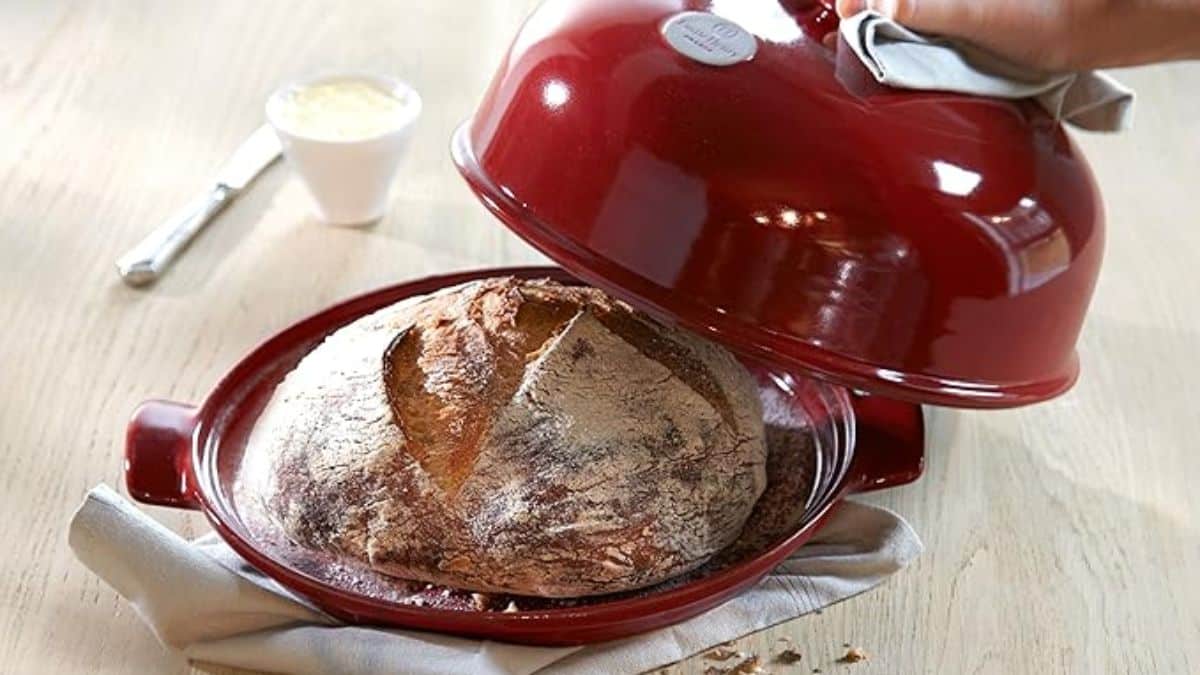
Ceramic bread ovens can give you a superior crust, and we love this one from Emile Henry. It’s made from all-natural clay and has a perfectly domed lid to trap steam, just like a traditional bread oven. The ceramic is also high-resistance, which means it can handle temperature changes without shock — you can move it directly from the refrigerator to the oven and from the oven to your table. It’s also microwave- and broiler-safe, which is rare for a bread cloche.
The side handles are on the smaller side, but it has an easy-to-grip knob on the top of the lid that you can easily grab, even with oven mitts. Plus, at just 6.5 pounds, it’s more lightweight than many of the other options. While the color options are limited, it also has a glossy finish that looks beautiful on your counter.
The Specs:
- Weight: 6.5 pounds
- Max Temp: 515 degrees F
- Diameter: 11.2 inches
- Material: Ceramic (all-natural clay)
- Care: Dishwasher-safe
The Pros:
- Lightweight
- Easy to clean
- Non-stick interior
- Microwave- and broiler-safe
The Cons:
- Smaller capacity
- Small side handles
What Others Are Saying
Since this is a round bread cloche, Food & Wine chose it as the best for making boules.
Buy the Emile Henry Bread Cloche:
Other Bread Cloches to Consider
Segretto Cookware Enameled Cast Iron Bread Oven
Because of the cast iron construction, this could be an alternative to the Le Creuset at a more budget-friendly price. However, Blair and I didn’t think it quite beats out the Le Creuset in quality, especially since it doesn’t have as many reviews. The Segretto Cookware Enameled Cast Iron Bread Oven is available at Amazon for $139.
Wekigai LoafNest
While the Wekigai LoafNest has a high number of Amazon reviews, the brand isn’t as well-known as the other winners on the list and Blair also hasn’t tried it herself. The silicone lining is a cool concept though, and it could be a good option for those who are looking to prioritize a non-stick surface. The Wekigai LoafNest is available at Amazon for $209.
Breadtopia Cloche Clay Baker
This is a good budget-friendly pick, but the oblong shape may not be for everyone. If you want a more rustic-style bread, round is the way to go, but this could be a good option for those who want to make long baguettes. The Breadtopia Cloche Clay Baker is available at Amazon for $89.
Emile Henry Modern Bread Cloche
This bread cloche performs just like the traditional bread cloche from Emile Henry, but Blair and I prefer the top-handle design on that one. We think it makes it easier to open the lid, especially when you’re wearing oven mitts. However, if you prefer the modern design, which still offers a highly resistant glaze and easy release, you’ll likely be happy with this version. The Emile Henry Modern Bread Cloche is available at Amazon for $157.90.
Why You Can Trust Us

Hi! I’m Lindsay, a functional nutritionist, recipe creator, and author of 15 cookbooks. I’m also a professional product reviewer, and have personally baked many loaves of bread at home using various bread ovens and Dutch ovens. I worked on this roundup of the best bread cloches with Blair, the founder of The Seasoned Mom and an avid bread-baker.
Together, Blair and I did extensive research to come up with our list of the best bread cloches. First, we narrowed it down to the top manufacturers and then read through buying guides from expert review sites to fine-tune our picks. We considered performance, material, design, and weight. Once we had a short list of finalists, we compared them side by side to narrow them down even further, ultimately ending up with five winners.
What to Know About Bread Cloches

Things to Consider When Choosing a Bread Cloche
There are a few factors to think about prior to purchasing a bread oven:
- Material: Traditionally, bread cloches are made from clay or unglazed stoneware that you soak in water to create the perfect humidity. While you can still find these options, cast iron (and enameled cast iron), ceramic, and silicone are all popular options, too. Blair recommends cast iron, ceramic, and clay, but silicone isn’t as heavy-duty and doesn’t give the bread the same delicious crust.
- Design: The design of the cloche determines the shape of the loaf. A round cloche will make a rustic, round loaf, while a rectangular or oblong-shaped cloche will make longer, narrow bread that works better for sandwiches. This is largely a matter of personal preference, but it’s something to think about when choosing one. In addition to the shape of the pan, you might also want to look for easy-to-grab handles and a knob on top of the lid that makes it easier to open.
- Weight: Bread cloches can be heavy — some weigh as much as 20 pounds! Generally, cast iron is the heaviest, but it does offer superior performance. When choosing a bread cloche, make sure you’re comfortable with the weight so you can confidently hold it and move it from the oven to the counter.
- Care: Care is largely dependent on the material of the bread cloche. Traditional cloches are made from unglazed clay, which is really porous. When working with an unglazed cloche, you have to be really careful not to use any soap or harsh ingredients and clean with water only (this can mean more scrubbing). Other bread cloches are dishwasher-safe, so you don’t have to worry about scrubbing them at all. You’ll also want to think about whether the cloche needs to be regularly seasoned, which impacts the level of maintenance.
What is a Bread Cloche?
A bread cloche (which means “bell” in French) is a dome-shaped pot that’s designed to bake the perfect loaves. The shape of the pot mimics a traditional bread oven and helps trap steam and moisture to create the right level of humidity for bread making. The result is a crispy crust with a light, airy interior. While traditional bread cloches are made from clay, you can find them in cast iron and enameled cast iron, too.
Bread Cloche vs Dutch Oven
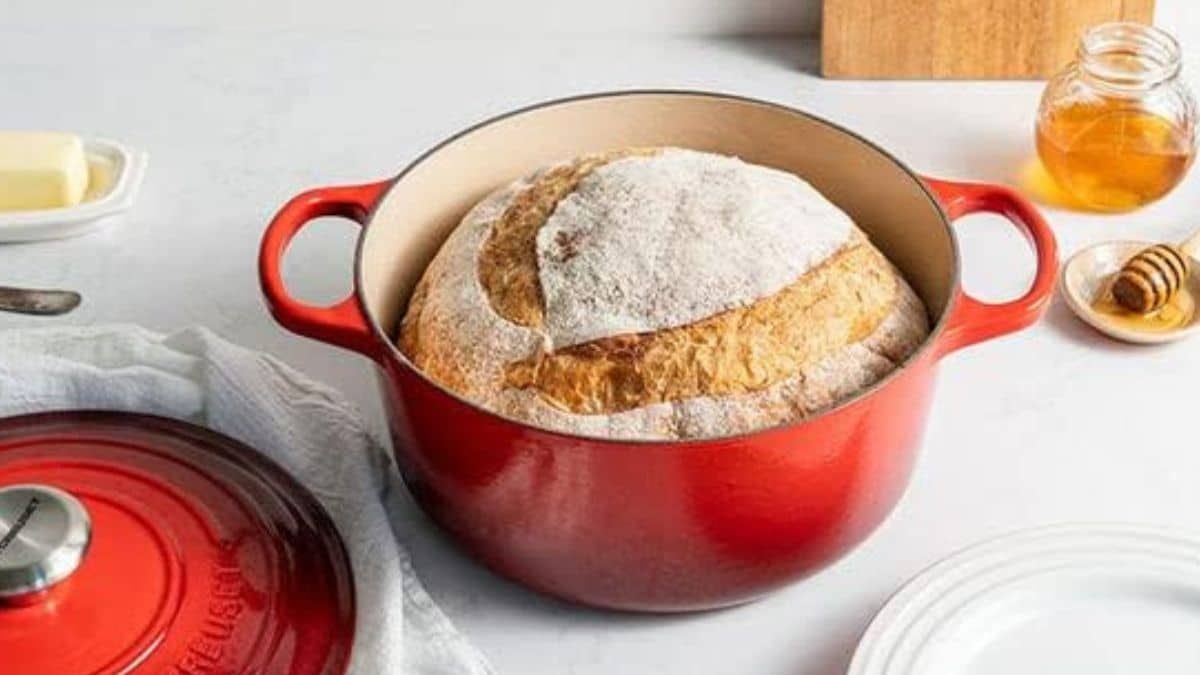
You can use either a bread cloche or a Dutch oven to make fresh bread at home. In fact, Blair often uses her Dutch oven to make round, rustic loaves. There are some limitations to using a Dutch oven though: For starters, they’re typically deeper than bread cloches, so you can get some uneven browning on the sides of the bread. Because the bread isn’t exposed to as much heat on the sides, you may also have to bake it longer, which can make the crust thicker than you’d like.
The upside to Dutch ovens is that they’re more versatile. In addition to making bread, you can make braises, roasts, stews and soups — you can’t do that with a bread cloche. Ultimately, the choice comes down to what you want to do with the pot. If you want cookware that excels at making bread only, choose a cloche. If you want a more versatile pot, a Dutch oven may be a better choice.
How to Use a Bread Cloche
The right way to bake with your bread cloche depends on the material and your bread recipe, but there are two ways people typically use one: a cold method and a preheated method.
With the cold method, you put your dough in the cloche and then put it in a cold oven. The cloche heats up as the oven preheats.
With the preheated method, you put the empty cloche in the oven and preheat the oven to your desired temperature. After the cloche has been in the preheated oven for about 30 minutes, you carefully take it out, add your dough, and then return it to the oven to bake.
For both methods, you may first want to oil the bread cloche and dust it with flour, or add a layer of parchment paper to prevent sticking, but it depends on the bread cloche you’re using.
My Favorite Bread Recipes

If you need some inspiration to put your bread oven to good use, here are some of Blair’s favorite bread recipes. While they may call for a Dutch oven, you can use a bread cloche instead.
Prices were accurate at the time of publication.
